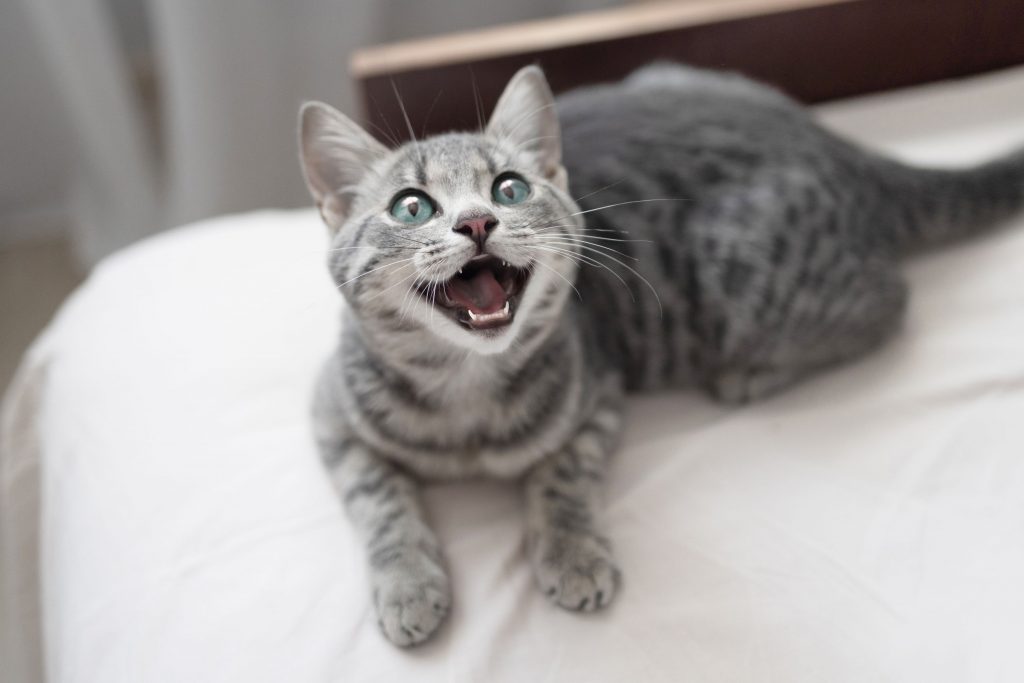The Feline Fanatic’s Guide to Cat Hyperthyroidism

Some of our feline friends have the ability to eat whatever they want and still lose weight. No, it’s not the latest fad diet, and honestly it is not as good as it might sound, either. A super metabolism might sound appealing, but the reality is that it can have some pretty detrimental effects.
Cat hyperthyroidism is a real medical diagnosis and fairly common one that we see in middle-aged to older felines at Dupont Veterinary Clinic. Our expert team is able to diagnose this condition and manage it well so that our cat patients can live long and healthy lives.
Cat Hyperthyroidism
The thyroid gland is an important, but often forgotten organ that plays a big role in day-to-day metabolic function. The thyroid is part of the endocrine system, the body system that is responsible for secreting hormones. Hormones like insulin, growth hormone, and cortisol are an essential part of physiology.
The thyroid gland itself secretes thyroid hormone, which plays a major role in metabolism. Cat hyperthyroidism in cats occurs when the thyroid gland produces too much hormone.
Overproduction of thyroid hormone is usually due to a tumor in the thyroid gland itself. While the tumor is often not malignant, the excess of hormone production results in a hypermetabolic state responsible for the symptoms of hyperthyroidism. These include:
- Weight loss
- Increased (often ravenous) appetite
- Digestive problems like vomiting or diarrhea
- Agitation/hyperexcitability
- Vocalization
- High heart rate
- Increased blood pressure
Untreated, hyperthyroidism in cats can lead to serious consequences and even death. Cats who are exhibiting symptoms should be evaluated right away. Contact us if you have concerns about your cat.
Because several other common health conditions can appear similarly, it is important for us to perform diagnostic tests in order to come to an accurate diagnosis.
Treating Hyperthyroidism in Cats
Thankfully hyperthyroidism in cats is typically manageable. The goal of treatment is to stop the thyroid gland from overproducing thyroid hormone.
Suppression of thyroid hormone can be accomplished in a few different ways:
- Surgical removal of the thyroid gland – In some instances, the actual removal of the thyroid gland may be indicated. This option is typically effective, however when the thyroid gland is removed, so is the attached parathyroid gland. This can result in problems related to calcium and phosphorus regulation within the body. Some cats who have their thyroid gland surgically removed may also need to have thyroid hormone supplementation administered for the rest of their life in order to prevent symptoms of hypothyroid (too low) function.
- Iodine restriction – The thyroid gland requires iodine to synthesize thyroid hormone. Severely restricting iodine intake through the use of a prescription diet can be an effective option for some cats.
- Inhibition of hormone production – Many cat owners choose to utilize daily medication called methimazole that inhibits thyroid hormone production. This medication is typically administered in pill form, although it can be made into a liquid or transdermal lotion. This type of management does require frequent blood monitoring. Over time, dosages may need to be changed. There is also a chance this treatment can eventually become less effective.
- Radioactive iodine treatment (I-131) – The use of radioactive iodine is a straight-forward way to deal with hyperthyroidism in cats. With this type of treatment, the patient is given a one-time injection of I-131, which targets the thyroid gland and greatly decreases thyroid hormone production. For most cats, this option results in a 95% or better cure rate.
Cat hyperthyroidism can be a serious condition, but with appropriate interventions, it is often quite manageable. Staying on top of your cat’s wellness care can help us to detect this disease before it becomes serious, as can letting us know right away if you have concerns. Together we can help your kitty live a long and happy life.
